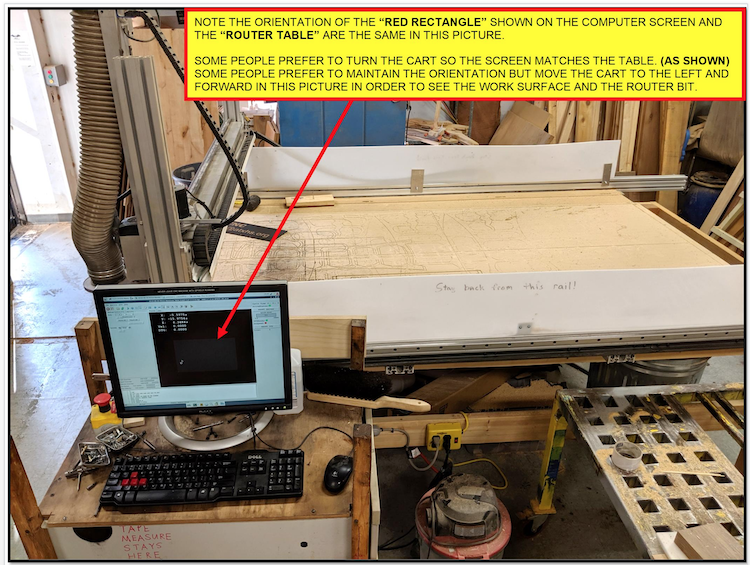Big CNC
The Big CNC is a custom CNC router designed and built by Danny Miller. It has a maximum cutting area of 5' by 8'
Max Z height is approx 7.5" from nut to spoilboard, but this does vary as spoilboard is added or removed. Note that the max usable stock height will typically need room for your bit to go on top of it
Spindle 3KW digitally-controlled VFD using an ER20 collet system. Manual bit changes, no ATC.
LinuxCNC control system
Z-height may be set by wireless toolsetter provided, or eyeballing it
CAM postprocessor should be "LinuxCNC", and not an ATC version. If nonarcs is an option, this is recommended over the arc option, but arcs will work. LinuxCNC used to be called "EMC2" long ago, "EMC2" postprocessors should work.
Cuts wood, plywood, plastic, many other materials. It is also capable of cutting nonferrous sheet metal and billets (thick blocks of metal stock) with proper feedrates and compressed air nozzle. The compressed air nozzle will drive chips out of the cutting area so they are not re-cut by the bit and provide some cooling.
CANNOT CUT STEEL. Steel requires coolant which is not compatible with the MDF bed. Steel can create red-hot chips and sparks which can start a dust collector fire, a very dangerous situation.
![]() Members must complete the Big CNC Class before using this tool
Members must complete the Big CNC Class before using this tool
Checklist
Before I Start
- Make sure rail travel is free of obstructions such as vacuum carts
- Switch on the two power outlets
- Wear Glasses and Closed Shoes
- Fix your work to the table (nylon nails, screws, double sided tape)
- Mount the bit
- Unrack & Home
- Switch on Dust Collection
When I'm done
- Shutdown the two power outlets.
- put wrenches, bolt, thingy back in the box in the CNC cabinet.
- Clean up the remaining dust.
Tooling
Users must bring their own bits. All CNC routing bits should be carbide, not HSS (High Speed Steel). HSS will not damage anything but the performance on wood, plywood, plastics, etc is poor.
An RCK-2249 surfacing/rabbeting bit is provided in the cabinet. This is an excellent choice for surfacing lumber slabs (live edge table) and pocketing. The 2 cutters on bottom of the bit plane the surface for a smooth face. It is 1-1/2" and uses two different types of carbide inserts which you will want to bring along with screws if you want to get the best quality cut. Larger diameter bits typically do not produce as good a finish, as any tram error (the spindle not being perfectly perpendicular to the surface) tilts the circle the bit makes which creates a slight scalloping of the surface and this requires more sanding to smooth out.
https://www.toolstoday.com/v-11847-rc-2249.html
The Diamond-Like Carbon inserts RCK-70-DLC and AMA-12-DLC are the best choice for surfacing lumber. This bit CANNOT PLUNGE it must approach the work from the side.
Places to get bits in town
Sparktech in Round Rock has a very comprehensive range of carbide tooling appropriate for CNC routing http://www.sparktechinc.com/
Easiest shopping is through eBay, most inventory is listed. Select "local pickup", check out, drive to Sparktech
- Sparktech's ebay store is CarbidePlus aka OliverToolCompany, username is DrillMan1 https://www.ebay.com/str/carbideplus?_trksid=p2047675.m3561.l2563
- Woodcraft (limited range). Note that most hand routing bits are not appropriate for CNC
- Dixie Tool Crib https://www.dixie-tool.com/
Online
- Amazon
- eBay
- https://www.toolstoday.com/
Full ER20 collet system provided in Inch and Metric. However, they are communal and prone to wear which adds runout and reduces the hold, and you may wish to get your own collets so you know the condition. Collets are generally cheap, the Techniks brand is consistently higher quality for about $15-$20 collet. In practice the majority of carbide tooling is 1/8", 1/4", and 3/8", so that may be the only Techniks collets you need to get. The ER20 nut is provided and generally does not have wear issues so it is not necessary to bring your own.
https://www.amazon.com/s?k=techniks+collet+ER20&ref=nb_sb_noss
Videos explaining differences of upcut, downcut, and compression bits on wood.
https://www.youtube.com/watch?v=seAmL6mtqgM
Those are the 3 most basic types. There are many other types
- straight mill
- ball mill
- taper mill
- v-carver
- surfacing bits.
Within a type, there are variations in:
- flute count
- flute geometry
- flue length/diameter
- shank length/diameter
- coatings (DLC, Spektra) reduce friction, cut slightly cooler, and last longer
- Some bits have replaceable carbide insert cutting edges.
Video explaining superglue-and-tape holddown method
https://www.youtube.com/watch?v=gTUAAm0DFOQ
Conventional drill bits can be chucked in the ER20 system. Please use the tightest collet available, which may mean selecting a metric. Any slippage between collet and tool will generally damage the collet.
Resources
Maintenance
This tool is owned by Danny Miller and hosted at Asmbly for members to use. Please submit a problem report if maintenance is required.
